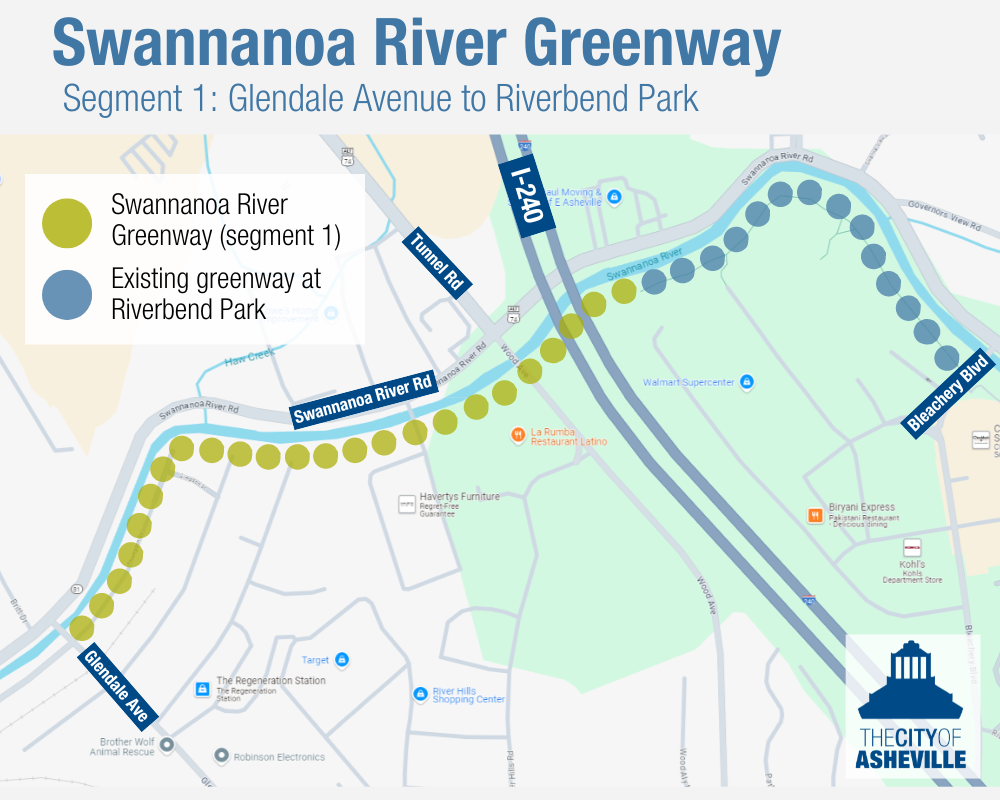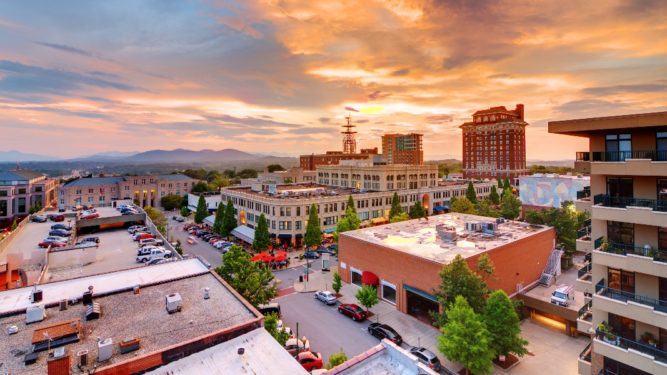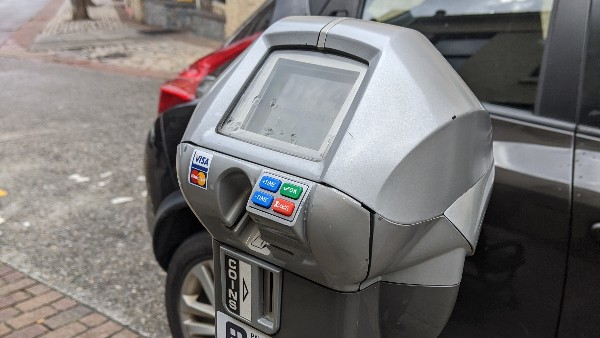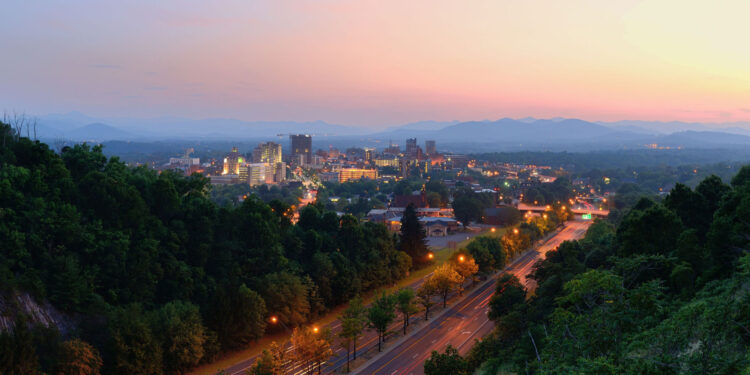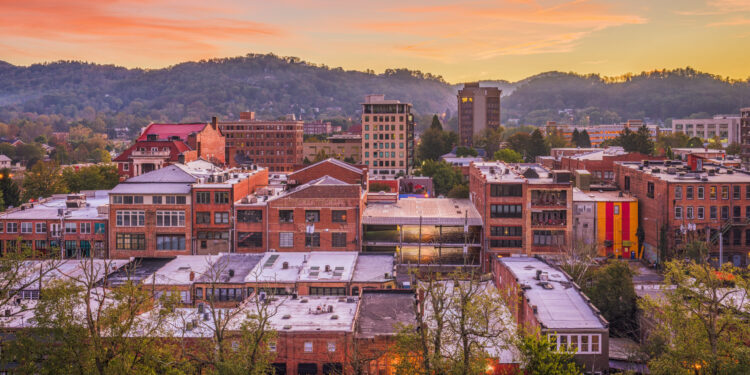Overview
The Swannanoa River Greenway starts at the intersection of Lyman Street and Amboy Road and ends at the city limits located at Azalea Road and Tunnel Road. Since the Swannanoa River Greenway corridor stretches 7.5 miles in length, greenway construction will occur in segments rather than be completed simultaneously.
This video provides a more detailed explanation of the Swannanoa River Greenway project. (Construction timelines have changed since the creation of the video.)
Happening Now
Construction on Segment 1 of the Swannanoa River Greenway began in September 2024. Initially this project was estimated to take 12 months to complete. However, due to significant damage from Tropical Storm Helene, the project area needs to be re-surveyed to determine impacts on existing conditions. Updates will be provided as available.
This segment begins at the intersection of Glendale Ave and Thompson St. At a little over one mile in length, this segment will follow the river behind businesses along the Swannanoa River and will terminate at the intersection of Bleachery Road and Swannanoa River Road. Improvements to the existing greenway in Riverbend Park are included in this segment. Future phases of the greenway will be implemented in conjunction with a future Swannanoa River Road Improvement project led by the North Carolina Department of Transportation.
Background
The Swannanoa River Greenway project is a 2016 voter-approved Transportation Bond project and was identified as the City’s number one priority greenway in the GAP Plan. The project is also part of the future 100-mile Fonta Flora State Trail, connecting Morganton to Asheville.
Below is a design rendering of the first segment of the Swannanoa River Greenway.
Several studies to identify preferred greenway alignments or design segments of the Swannanoa River Greenway have been conducted or are in progress.
In 2018, The City of Asheville conducted two studies on different segments of the Swannanoa River Greenway:
- Swannanoa River Greenway Feasibility Study (Phase 1) was a feasibility study and greenway corridor design on the eastern end of the greenway starting at the intersection of Thompson St. and Glendale Ave. and ending at the City of Asheville’s park complex with the Nature Center, Recreation Park and JB Lewis Soccer Fields. This study included the design for the first segment of the greenway from Thompson St. to Bleachery Blvd.
- Swannanoa River Greenway Corridor Study (Phase 2) was a planning-level study funded through the North Carolina Department of Transportation’s (NCDOT) Bike and Pedestrian Mini-Grant Program for the section of the greenway that starts at Biltmore Avenue and ends at the intersection of Thompson Street at Glendale Avenue. This study did not include engineering and design in the scope of work.
In 2023, the French Broad River Metropolitan Planning Organization (FBRMPO), with funding from NCDOT, kicked off a consultant-led feasibility study for another segment of the Swannanoa River Greenway that would begin. The study area begins near the intersection of Meadow Road and Biltmore Estate Drive and ends at Biltmore Avenue. The Swannanoa River Greenway Extension Feasibility Study investigates the existing conditions of the area, analyzes different route options to identify opportunities and constraints, provides cost estimates, and proposes strategies for the implementation of the greenway extension. The study also offers an action plan for implementing the recommended infrastructure. It is anticipated this study will be finalized in Fall 2024.
Supporting Documents
The City of Asheville Close the GAP Plan
The City of Asheville 2013 Greenway Master Plan
The Buncombe County Greenway Master Plan
The Hellbender Regional Trail Plan
Timeline
2018
After the 2016 voter-approved bond, the City of Asheville conducted two studies on segments of the Swannanoa River Greenway: Swannanoa River Greenway Feasibility Study (Phase 1) and Swannanoa River Greenway Corridor Study (Phase 2).
2020
Design work completed for the first greenway segment (Glendale Ave. to Bleachery Blvd.)
2021
September: Public Meeting for feedback on the greenway design for the first greenway segment (Glendale Ave. to Bleachery Blvd.)
2022
City Council adopted the GAP Plan, identifying the Swannanoa River Greenway as the City’s number one priority greenway.
2023
Design documents completed, bid posted for construction for the first greenway segment (Glendale Ave. to Bleachery Blvd.)
Summer: The FBRMPO kicks off the Swannanoa River Greenway Extension Feasibility Study for the segment of greenway starting at the intersection of Lyman Street and Amboy Road and ending at Biltmore Avenue.
2024
Permitting and review
Construction start for first segment
Anticipated completion of the Swannanoa River Greenway Extension Feasibility Study
2025/2026
Anticipated construction completion of first segment
Contact Information
Lucy Crown, Greenway Planner, Transportation Department
Dustin Clemens, Capital Projects Division Manager, Capital Management Department

